Principal Balanced Advantage Fund: Stability in volatile markets

The most important part of investing for one’s goals is asset allocation in accordance with the investor’s risk appetite. Most investors are not able to get this right; either they take too much risk or they take too little risk - both are harmful for the long term financial well-being of the investor. It is important to take the right amount of risk through an optimal mix of equity and fixed income investments. If you are young (have high risk appetite), equity should form the maximum portion of your asset allocation while, if you are nearing retirement your asset allocation should be skewed towards fixed income.
There are two approaches to managing asset allocation. In one approach, you determine your target asset allocation and stick to it until your risk appetite changes. Over a period of time your asset allocation will deviate from the target change due to differential rates of equity and fixed income returns in different market conditions. Therefore, it is important to rebalance your asset allocation from time to time, but not too frequently because there may be transaction costs (e.g. STT, exit loads etc.) and capital gains tax implications associated with frequent re-balancing. If you are targeting a fixed asset allocation, then you should be prepared to face high volatility in your portfolio, especially if your asset mix is skewed towards equity because equity is a volatile asset class, but if you remain disciplined then you can achieve your long term goals.
The other approach to managing asset allocation is a dynamic one with the idea of optimizing risk. This approach is suitable for investors who prefer portfolio stability – in our experience, majority of retail investors in India fall in this category. How do you optimize / reduce risk? By buying low and selling high– the age old mantra of equity investing. The benefit of buying low and selling high is obvious, but it is very difficult to execute. For example, what is the definition of low and high, how to execute it, what are transaction costs and tax implications etc. Dynamic Asset Allocation Hybrid Mutual Funds, also popularly known as Balanced Advantage Funds offer investors dynamic asset allocation solutions based on market movements.
What are Balanced Advantage Funds?
These mutual fund schemes dynamically rebalance their asset allocation between equity and fixed income (debt) based on stock market valuations based on a dynamic asset allocation model. The dynamic asset allocation model is back-tested (tested with historical data) to ensure that the investment objectives are met in different market scenarios. If equity valuations are low, then the model will suggest a shift in asset mix from debt to equity – higher percentage of equity in asset mix. If equity valuations are high, then the model will suggest a shift in asset mix from equity to debt – higher percentage of debt in asset mix. In essence, Balanced Advantage Funds book profits in stocks in up markets and invest in debt. This reduces the risk profile of the investment portfolio on a continuous basis in up markets and consequently when the market falls, the downside risk is limited. When stock prices have corrected in down market and valuations appear cheap, the fund will buy stocks, shifting from debt. This is how Balanced Advantage Funds are able to buy low and sell high.
One of the biggest benefits of Balanced Advantage Funds is that they enjoy equity taxation – short term capital gains (investment held for less than 12 months) are taxed at 15%, while long term capital gains (investment held for more than 12 months) up to Rs 1 lakh are tax free – long term capital gains in excess of Rs 1 lakh are taxed at 10%. Dividends paid by Balanced Advantage Funds are tax free in the hands of the investor, but the fund house has to pay 10% dividend distribution tax (DDT).
Principal Balanced Advantage Fund
Principal Balanced Advantage Fund (previously known as Principal Smart Equity Fund) work on the dynamic asset allocation strategy described above. The dynamic asset allocation model of the fund defines valuation (Price to Equity Ratio) bands and corresponding asset allocation ranges for each band. PE bands work better than absolute PE levels because it gives the fund managers the latitude of managing asset allocation changes within the band, reduces impact cost of sudden asset allocation changes and reduce volatility of returns. The fund has given nearly 10% annualized returns since inception and more than 13% annualized returns in the last 5 years.
The fund was launched in 2010. Its expense ratio is 2.5%. P.V.K Mohan and Beckxy Kuriakose are the fund managers of this hybrid scheme. The chart below shows the NAV movement of the fund over the last 5 years. Notice that the NAV movement is fairly smooth – no big fluctuations in the last 5 years.
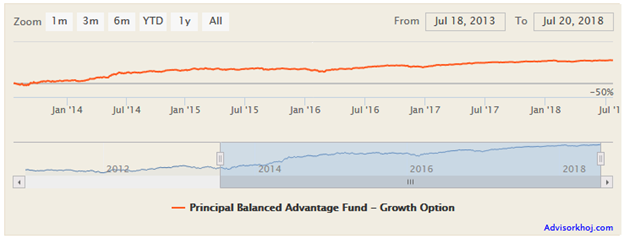
Source: Advisorkhoj Research
Rolling Returns
The chart below shows the three year rolling returns of Principal Balanced Advantage Fund since inception.
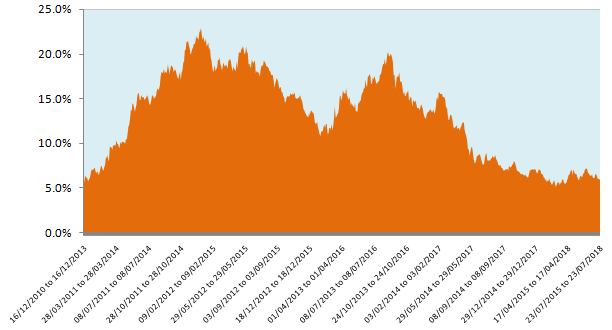
Source: Advisorkhoj Research
Investors should notice how downside risks are limited over 3 year investment tenor in Principal Balanced Advantage Fund. The minimum 3 year rolling returns is 5.2%. The average 3 year rolling return is 13.2%, while the median 3 year rolling return is 14%. The maximum 3 year rolling return is 23%. This shows that, the fund had enabled investors, over a sufficiently long investment tenor, to capture the upside potential, while limiting downside risks.
How Principal Balanced Advantage Fund provided stability to investors
The chart below shows the monthly rolling returns of Principal Balanced Advantage fund since inception.
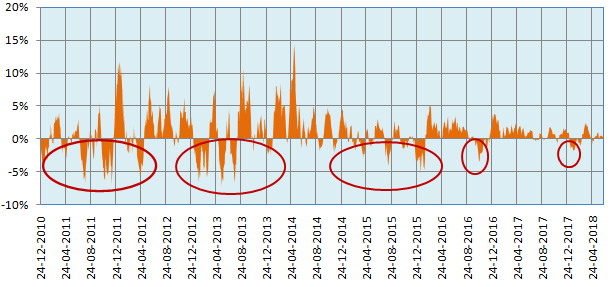
Source: Advisorkhoj Research
We have circled the most volatile periods for stock market since the inception of the Principal Balanced Advantage Fund nearly 8 years back. We had two bear markets in this period (more than 20% correction) – in 2011 and 2015 / 2016; we also had periods of high volatility in 2013 and 2018. Notice how downside risk in volatile markets was protected by the fund. 2015 is a great example; while Nifty fell by 4%, the fund gave 3% positive returns.
The chart below shows the movement of Nifty – 50 TRI index versus the Principal Balanced Advantage Fund’s NAV since inception. The primary axis on left represents Nifty – 50 TRI values, while the secondary axis on the right represents the NAV of Principal Balanced Advantage Fund. Notice the periods circled in red - you will see how the fund was able to limit downside risks for investors in periods where Nifty saw a sharp correction.
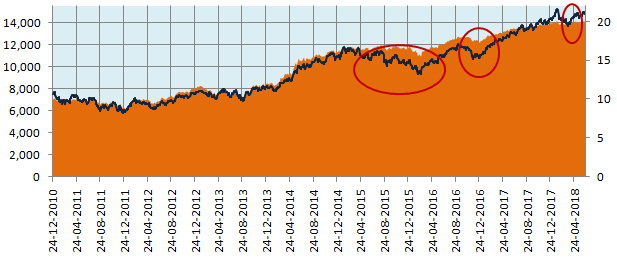
Average rolling returns and volatility
The chart below shows the annualized average monthly rolling returns and standard deviations of rolling returns over various periods. You can see that over long investment tenure the average rolling returns are higher. Therefore, long investment tenures are recommended for this fund.
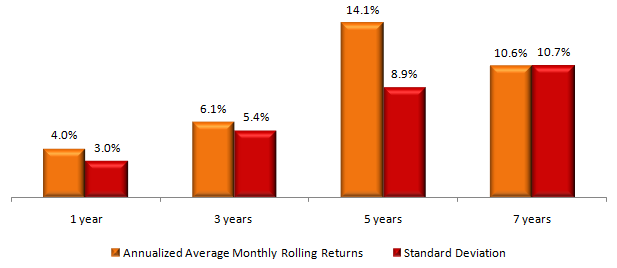
Probability distribution of returns
Assuming normal distribution (bell curve) of returns, we have estimated probabilities of different rates of returns based on 5 year monthly rolling returns of Principal Balanced Advantage Fund. For our quantitatively inclined readers, probability distribution of returns can be calculated using average, standard deviations and normal distribution table. Investors should understand that probabilities represent likelihoods, there is no assurance of returns – even if probability of getting high returns is 99%, there is still a chance that the investor can actually make a loss, however unlikely it is. With that understanding of probabilities, let us see the likelihood of different return scenarios.
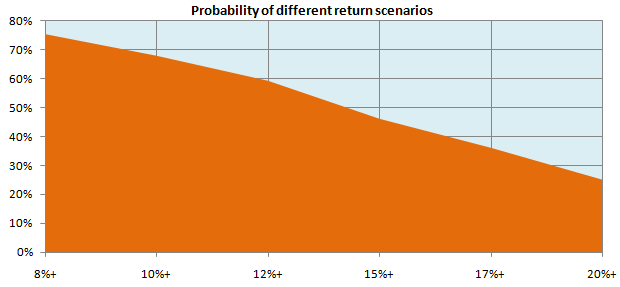
Source: Advisorkhoj Research
You can see that probability of getting 12%+ returns is around 60%, while probability of getting 8 to 10%+ returns is around 70 to 75%. You can also see that probability of getting 15%+ return is less than 50%, while that of getting higher returns is lower. Investors should not expect very high returns in balanced advantage funds, but the probability of getting moderately high returns, higher than fixed income, in balanced advantage funds is very high.
Let us now look at probabilities of downside risks, including probabilities of getting lower than risk free / fixed income returns. This compared to the upside scenarios, will help investors get a sense of the risk return trade-off, one of the most important considerations for investors.
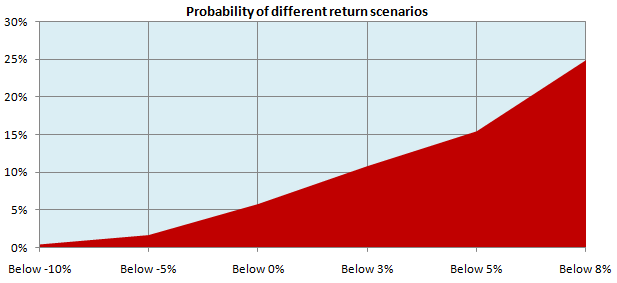
Source: Advisorkhoj Research
You can see that probability of making a loss is quite low – 5% or lower. Investors often compare mutual fund returns with assured returns they get from bank term deposits (FDs). Bank fixed Deposits on a post-tax basis give around 5% to 6% returns, depending on investor’s tax brackets. The probability of getting below 5 to 6% returns is only 15 to 20%. This shows that Principal Balanced Advantage Fund investors have a very high change (80 to 85%) of getting higher then fixed deposit returns on a post-tax basis.
Dividend Track Record
Principal Balanced Advantage Fund has a strong dividend payout track record. For the last 2 years, the fund has been paying regular monthly dividends. Average monthly dividend yield over the last one year or so has been more than 0.8%.
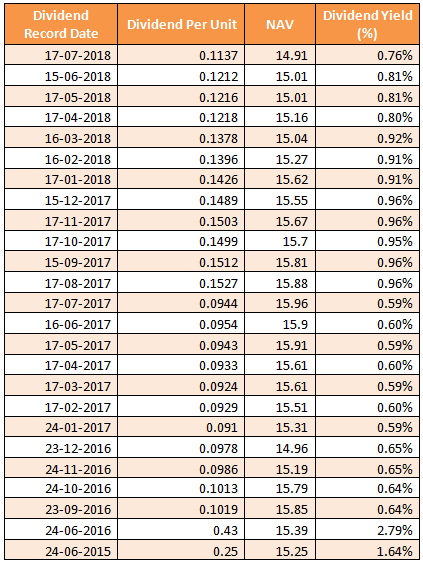
Source: Advisorkhoj Research
Conclusion
In this post, we discussed how Principal Balanced Advantage Fund works. We also discussed at length how the fund limits downside risks for investors through its dynamic asset allocation strategy. This makes the fund good investment options for investors with moderate to moderately aggressive risk appetites. In our view, investors should have long investment horizon to get the best returns from this fund. Investors should consult with their financial advisors if Principal Balanced Advantage Fund is suitable for their investment needs.
Mutual Fund Investments are subject to market risk, read all scheme related documents carefully.
Queries
-
What is the benefit of mutual fund STP
Aug 29, 2019
-
How much to invest to meet target amount of Rs 2 Crores
Aug 26, 2019
-
Can I achieve my financial goals with my current mutual fund investments
Aug 24, 2019
-
Can you tell me return of various indices
Aug 19, 2019
-
What would be the post tax return on different investments
Aug 18, 2019
-
Which Principal Mutual Fund scheme will be suitable for my retirement corpus
Aug 16, 2019
-
What is the minimum holding period for availing NCD interest
Aug 4, 2019
Top Performing Mutual Funds
Recommended Reading
Fund News
-
The Wealth Company Mutual Fund launches The Wealth Company Gold ETF FOF
Jan 9, 2026 by Advisorkhoj Team
-
Mahindra Manulife Mutual Fund launches Mahindra Manulife Innovation Opportunities Fund
Jan 9, 2026 by Advisorkhoj Team
-
Jio BlackRock Mutual Fund launches Jio BlackRock Short Duration Fund
Jan 8, 2026 by Advisorkhoj Team
-
Jio BlackRock Mutual Fund launches Jio BlackRock Low Duration Fund
Jan 8, 2026 by Advisorkhoj Team
-
Groww Mutual Fund launches Groww Small Cap Fund
Jan 8, 2026 by Advisorkhoj Team














